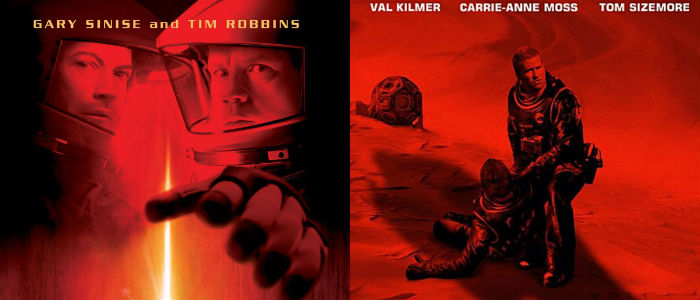
(Welcome to Seeing Double, a series where two strangely similar films released around the same time are put head-to-head. This time, we leave the safety of Earth behind and head towards Mars in search of adventure, the future of the human race, and some intergalactic mediocrity.)
Original movies come out of Hollywood – it’s true! – but much of its output consists of films inspired by previous successes. They’re mostly visible in the form of direct sequels, of course, but they also come from studios trying to mimic a hit in tone, style, and/or genre. Michael Bay’s Armageddon was the second biggest box-office hit of 1998, so it was no real surprise that some similarly themed films went into production soon after.
Disney tried recapturing their own magic with Mission to Mars, while Warner Bros. entered the fray with Red Planet. (Hell, it’s entirely possible that Clint Eastwood’s Space Cowboys got the green light for the same reason.) Both films put movie stars into a rocket and launched them on a mission to the red planet, and they opened exactly eight months apart in 2000. Nobody cared about either one.
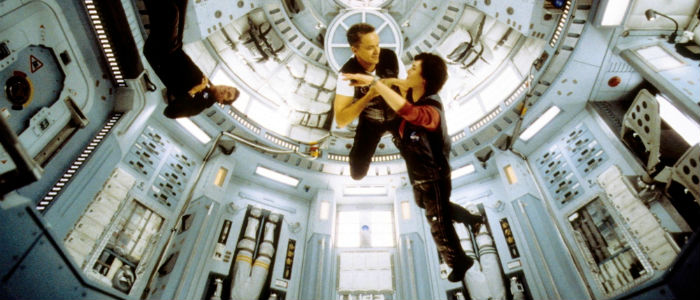
The Story
Mission to Mars opens in 2020 during a celebration for an impending mission to Mars that hopes to confirm the planet as a possible new home for humanity. NASA is sending a team of astronauts into space, and thirteen months later they’re roaming the planet’s surface in search of a possible water source when they find something strange. A sand storm swirls around a mountain and begins picking apart the team – quite literally in one poor shlub’s case – before revealing a newly exposed alien face carved out of the earth. (The mars? How does this work exactly?)
Anyway, mission control back home receives a disturbing message from the doomed team’s commander. Realizing he’s still alive, NASA puts together a rescue mission, but things go awry before they even reach the planet. Tiny meteors, explosions, and a twenty-minute spacewalk sequence meant to be suspenseful but hampered by flat dialogue audio seemingly pulled from rehearsal see the rescue team decimated. The survivors finally reach the planet’s surface – we know this because someone back on Earth says “They did it!” – where they find a frazzled commander barely hanging on. A quick round of DNA Sudoku later and the giant face opens as if to welcome them. Sounds impossible, I know, but as one of them says “We’re millions of miles from Earth inside a giant white face. What’s impossible?” Turns out the face on Mars is an alien hangar, and one of our heroes is about to get a journey beyond the stars.
Red Planet sends astronauts to Mars on an even more desperate mission as the Earth is severely overpopulated by 2025. Humanity has been sending probes to the planet depositing algae on its surface in an effort to build an atmosphere, but now the oxygen levels are dropping and they don’t know why. The team – a female commander and a male crew including an engineer, a biologist, a philosopher, and a killer robot – heads to Mars in search of answers. Solar flares mess up their day, though, leaving the commander trapped on the orbiting ship while the others crash land on the surface and enter into a deadly game of survival. One is killed in the crash, another is “accidentally” knocked off a cliff, a third is torn apart by the robot, a fourth is eaten by bugs, and the fifth is left to shake his head and summarize the film’s theme with “Fuck this planet.”
Winner: Both films are similar in their initial setup as astronauts head to Mars in the hope of finding it suitable for human development, but they diverge dramatically in what they do once there. If the best Mars-centric genre effort is The Martian Chronicles (1980) and the worst is Ghosts of Mars (2001) then these two sit somewhere in between… but closer to the latter. Mission to Mars delivers a little bit of wonder and cheese in its rough mashup of Close Encounters of the Third Kind (1977) and The Abyss (1989), but in addition to being too little too late, its execution also leaves viewers unmoved by its denouement. Still, the film finds value in Mars itself which is enough to make its story the winner between the two. Red Planet can’t claim the same as some oxygen-farting bugs aside these astronauts may as well be fighting to survive in any of Earth’s deserts. The planet’s alien landscape and environment are barely a consideration which is disappointing. So Mission to Mars takes this one.
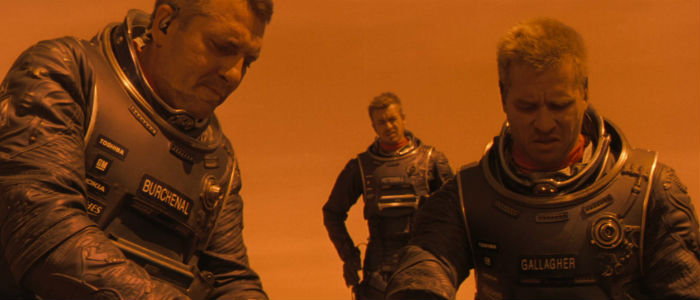
The Filmmakers
Brian De Palma was no stranger to genre films before helming Mission to Mars with several thrillers and a few horror films among his filmography, but he wasn’t a go-to name for big-budget blockbusters. That changed after he directed 1996’s Mission: Impossible to nearly half a billion dollars at the box-office. Nabbing him for their big sci-fi adventure was a strong move by Disney as while his films aren’t always great, they’re also never boring. People want to see the next De Palma. (Back then anyway…) The film’s three screenwriters may not have been equal rock stars, but the combined filmographies of Graham Yost and Jim & John Thomas include action favorites like Predator (1987), Speed (1994), and Broken Arrow (1996), so they were equally reliable picks. The film also nabbed De Palma’s regular editor Paul Hirsch whose career is littered with success stories including The Empire Strikes Back (1980), Ferris Bueller’s Day Off (1986), Falling Down (1991), and many more, and the audible icing on the cake? A new score by the legendary Ennio Morricone.
It’s almost unfair to compare all of that to Red Planet‘s behind-the-camera talents. It was director Antony Hoffman’s feature debut… and still his only feature nineteen years later. Writers Chuck Pfarrer and Jonathan Lemkin, meanwhile, gave us Hard Target (1996) and The Devil’s Advocate (1997), respectively. Composer Graeme Revell may not be Morricone, but he’s ultimately the most reliable off-camera name associated with the film having scored the likes of Dead Calm (1989), The Crow (1994), Strange Days (1995), and plenty more.
Winner: I mean, do I even need to say it? Mission to Mars, obviously.
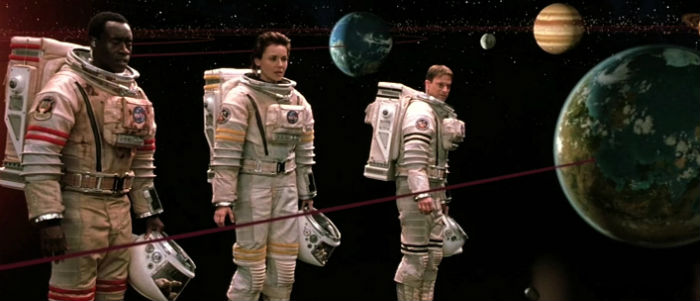
The Cast
Both films are basically disaster movies, albeit ones set in space, and as the sub-genre dictates they both feature ensemble casts consisting almost exclusively of familiar faces. Sure they’re mostly supporting players, but each features an A-lister or two as well. Mission to Mars landed Tim Robbins, Gary Sinise, Don Cheadle, Jerry O’Connell, and Connie Nielsen, while Red Planet nabbed Val Kilmer, Carrie-Anne Moss, Tom Sizemore, Benjamin Bratt, Simon Baker, and Terence Stamp.
Winner: This is easily the toughest category in this competition – okay fine, the only tough category – as both films deliver multiple talents of varying degree and likability. Yes, even O’Connell. Robbins, Kilmer, Sinise, Moss, Cheadle… they’re all skilled, highly watchable performers, but only one among them is having so much fun on the screen that he makes for a memorable member of the ensemble. If you guessed Kilmer, well, you’re correct. And he’s the reason Red Planet sneaks ahead to snag this category. If you prefer a mathematical breakdown then let’s just say it’s winning because it features six name stars to Mission to Mars‘ five.
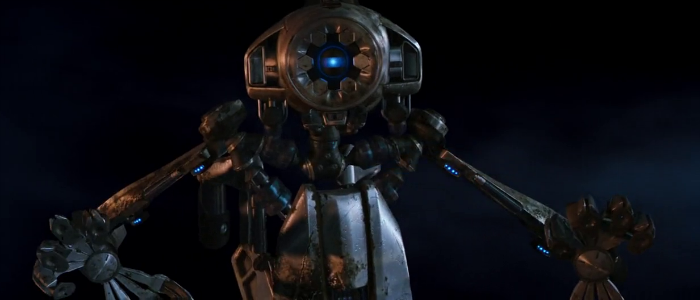
Critical Reception
Mission to Mars failed to wow critics and currently sits at 25% on Rotten Tomatoes with a barely better audience score of 30%. The positive comments showed some people inexplicably praising the visual effects including the Chicago Tribune’s easily impressed Michael Wilmington who says it’s “a film about space exploration that really knocks your eyes out.” I’m not even sure what that means. Criticisms, meanwhile, rightly focus on the clunky screenplay that seems constantly unsure which movie it wants to rip off next.
Red Planet fared even worse with a 14% RT score from critics (and 28% from audiences). It was again given credit for the visual effects while critical jabs are mostly focused on its flat script, weak dialogue, and lack of energy.
Winner: Both films are labeled rotten, but in the contest of which movie is held in less poor regard the “winner” is Mission to Mars. Fewer people dislike it, so that’s a win.
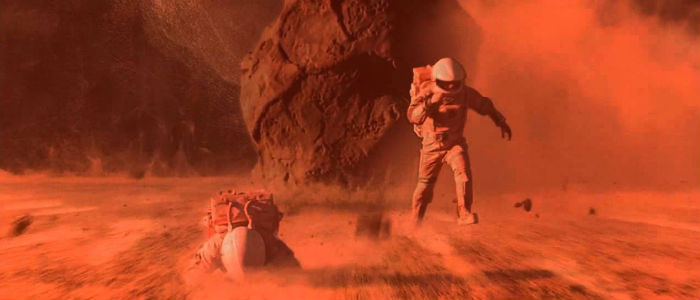
Budget and Box Office
Mission to Mars came in at a pretty penny back in 2000 with a reported budget of $100 million, and if you apply the usual marketing multiplier of 1.5x its cost approaches $150 million. It’s bad news either way as the film only earned $110 illion worldwide. That’s enough to make it De Palma’s second-highest grossing film, behind Mission: Impossible (1996) and ahead of Snake Eyes (1998), but it’s not enough to make it a financial success.
Red Planet cost less at $80 million – closer to $120 million with marketing — but hoo boy did it tank at the box office. The film only earned $33 million worldwide, and that my friends is a red planet-sized bomb.
Winner: This category is usually a relatively closer call but not this time. Neither film was a hit, but Mission to Mars lost less money making it a winner by default.
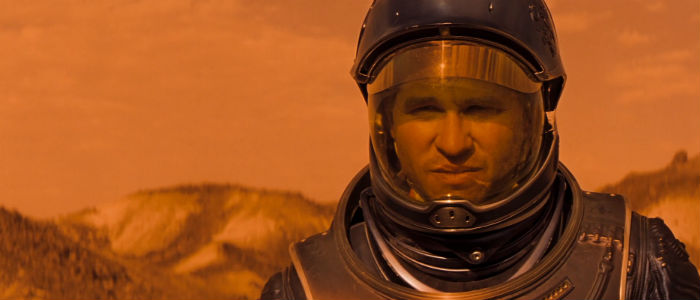
My Take
A rewatch confirms that neither of these movies are all that good despite the appealing casts and “cutting edge” visual effects. Regarding the latter, while critics seemed at least somewhat impressed by the special effects, I can’t help wondering why they pale beside the likes of The Abyss from eleven years prior. The underwater aliens in James Cameron’s epic still impress and leave viewers in awe while the alien in Red Planet… leaves viewers giggling. Action and suspense are minimal in both films leaving neither movie feeling all that memorable, and we’re stuck with a dull movie wasting an intriguing story and a slightly more fun one that fails to capitalize on its Mars locale. Judging by the category outcomes it’s clear that Mission to Mars is the winner, but it’s still not in any position to gloat.
Personally, I’d skip both and just re-watch The Martian (2015).
The post Seeing Double: ‘Mission to Mars’ vs ‘Red Planet,’ 2000’s Competing Sci-Fi Adventures appeared first on /Film.
from /Film https://ift.tt/2NuxG7o
via IFTTT
Comments
Post a Comment